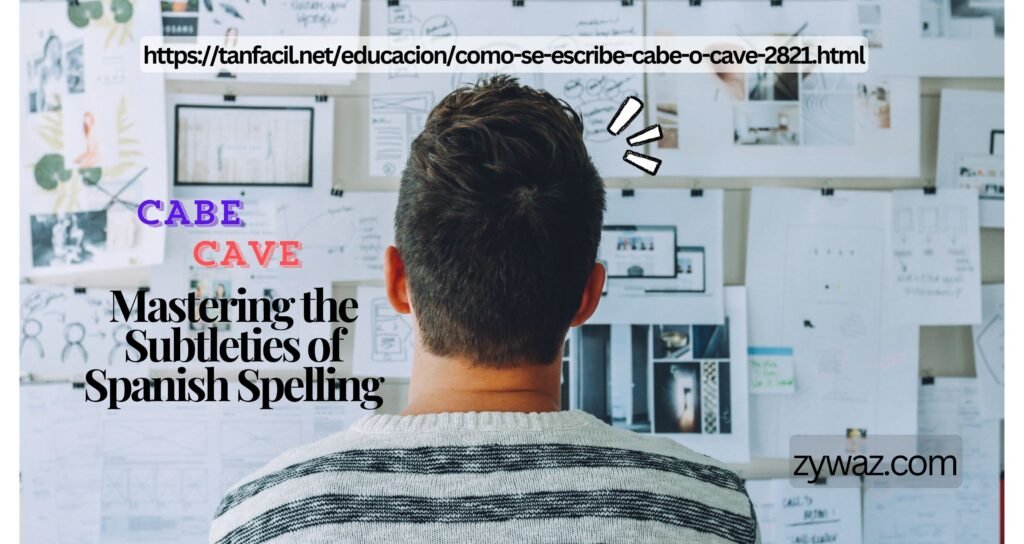Cabe vs. Cave: What’s the Difference?
Cabe” and “cave” are terminologies that are very close in pronunciation but very far apart in meaning and usage in Spanish. This article is going to get you in line with both terminologies so you could develop more your skill speaking and self-expression in Spanish. Knowing what is meant by “cabe” and “cave” will enable you to express yourself more correctly and confidently.
When to Use “Cabe”: A Preposition of Location
https://tanfacil.net/educacion/como-se-escribe-cabe-o-cave-2821.html
“Cabe” is a preposition meaning “next to” or “beside.” It has little use in modern Spanish but is still found in literature and formal writing. Understanding the right context will let you appreciate its nuanced role in the language.
Example:
- Sentence: La casa está cabe el río.
- Translation: The house is next to the river.
Cave”: Conjugation of “Cavar”
“Cave” is a verb form from “cavar,” which is Indo-European for “to dig”. More specifically, “cave” is the formal command form or the first person singular of the present subjunctive. Understanding when to use the verb form “cave” is crucial in giving the speaker or writer the ability to come up with grammatically correct sentences both in written and spoken Spanish.
Example:
- Sentence: Es necesario que yo cave en el jardín.
- Translation: It is necessary for me to dig in the garden.
Contextual Differences: Avoiding Common Mistakes
https://tanfacil.net/educacion/como-se-escribe-cabe-o-cave-2821.html
The wrong use of “cabe” and “cave” tends to cause a lot of confusion and misunderstanding. Here are some of the common cases with examples, that will help the reader to understand how to use these words effectively.
Example:
- Incorrect: La casa está cave el río.
- Correct: La casa está cabe el río.
Historical-Literary Use of “Cabe”
Although “cabe” no longer serves in modern sentence construction in everyday discourse, it definitely belongs to the historical and literary levels.The way it is used in classical Spanish literature may further enlighten its pertinence and the diachronic process it has undergone.
Practical Exercises to Master “Cabe” and “Cave”
Practice Exercises Also, you must do some practical exercises and look at examples to help fix the understanding in your mind. It tries to offer you the sentences and short paragraphs to allow you to practice—an exercise in applying your knowledge and spotting the correct usage.
Advanced Tips for Spanish Learners
Subtle differences, like “cabe” and “cave,” are very critical to master for one desiring to be fluent in Spanish. Knowing how to surmount the barriers and overcome these described differences with tips and advanced strategies for remembering will help one master language skills and promote communication.
FAQs
Q: Is “cabe” used a great deal in modern Spanish?
A: Not to any great extent in ordinary conversation, although it will be found in literature and formal writing.
Q: Would “cave” be used in formal and informal situations?
A: In formal imperatives or subjunctive, when the verb ends in -e, “cave” is used, so it feels quite formal.
Q: Other words like “cabe” and “cave”?
A: Surely, there are full and near-homophones in Spanish, some used only in a particular context. It is the understanding of the context which differentiates them.
Q: What is the right way to practice “cabe” and “cave”?
A: Such practical exercises, reading literature, and writing activities can impress proper usages onto the mind.
Q: Why are we expected to learn these differences?
A: Proper usage of “cabe” and “cave” gives clarity and preciseness to the idea that the speaker is trying to convey, and it prevents probable misinterpretation.
Conclusion: Precise Spanish Mastery
Mastering the difference between “cabe” and “cave” in Spanish is a small step towards greater understanding. One will be more effective if he knows what each of these terms means and where they occur. This learning will enhance your ability and confidence in Spanish, be it while reading some ageless classic literature or during day-to-day conversations. See more..

